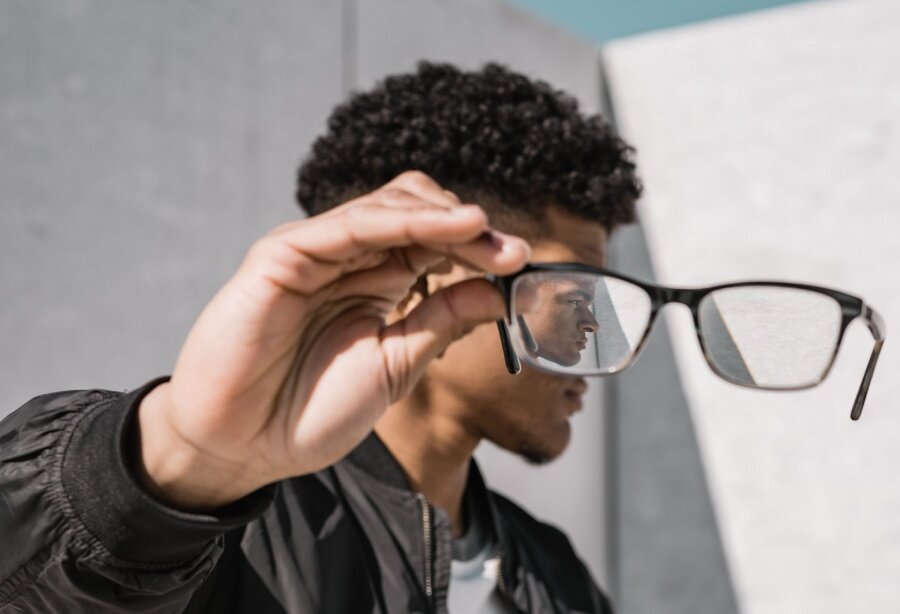What Are the Most Common Problems With Progressive Lenses?
Have your friends or colleagues ever complained to you about problems they were experiencing while using glasses equipped with progressive lenses? They may have complained to you about difficulty adjusting to their new glasses, not knowing where to look through the lens, eye strain or nausea, just to name a few. In this post I will break down the most common problems with progressive lenses, recommended steps for easier adaptation, and answer a few common questions.
Take the first step towards better vision by learning more about our specialized eye exam services.
Most Common Problems With Progressive Lenses
Nausea
Dizziness
Headache
Blurred Vision
Peripheral distortion
A patient who experiences difficulty adapting to progressive lenses might feel they have poor balance or that they walk wobbly with their new glasses. Perhaps the edges of their vision are disproportionately large, or disproportionately small. The edges of their vision could be bent as well. I’ve also heard of headaches or migraines in extreme cases, and it’s fairly common for complaints of nausea. These are all signs of adaptation to a multifocal lens. Let’s take a look at how to adapt.
How to Adapt to Progressive Lenses
Firstly, if this is a patient’s first experience with progressive lenses, I educate that it may take three to four weeks for them to fully adapt to the lenses. For these patients, I never recommend immediately driving with their new glasses on, as the brain has not had time to adapt yet. Trying to do higher order tasks right off the bat, such as driving, may cause dizziness, headache, or blurred vision.
The best environment to break into the new lenses is in the comfort of your own home. Start while sitting on the couch. Maybe just try watching television a little, while periodically gazing down at your phone. This will help you transition between far distance and near distance areas on the lens. Then, go ahead and walk around the house with the new progressive lenses. The most difficult exercise may be when going up and down the stairs.
The key point for success here is to remind yourself that the area delegated for distance vision is at the top part of the lens and the reading vision is at the bottom of the lens. So when going down stairs, just remember to tilt your entire head down and look through the top portion of the lens, not just move your eyes vertically down.
Choosing a well-fitting frame in which to embrace a pair of progressive lenses is an art form. There are so many different factors to consider and assess. It is not as simple as choosing any frame and plugging progressive lenses into the frame. It’s worthwhile to find a skilled optician who is able to recommend appropriately fitting eyewear for your new progressive lenses and one who takes all the necessary measurements such as the segment height and pupillary distance.
At Della Optique, we get many patients coming to us for a second opinion as they were unsuccessful with their new progressive lenses elsewhere. Most oftentimes, it is not a prescription error; it is more likely that a poor-fitting frame was chosen or a lower quality progressive lens was selected. For a detailed overview of what progressive lenses are and their design, visit my earlier blog post.
Frequently Asked Questions
Why Are My Progressive Lenses Blurry?
There may be many contributing factors for blurriness with progressive lenses. If it is your first pair of progressive glasses, there is always a learning curve. Your optician will illustrate how a progressive lens is designed and how it can be efficiently used for all distances. When first learning, the brain does require a few weeks to adapt to this change. With time, looking through the multifocal lens becomes seamlessly integrated into the wearer’s muscle memory.
The first step when using progressive lenses is to become comfortable using those designated areas of the lens for each distance-specific task. For example, if the lower portion of the lens (which is specific for reading vision) is used to watch television, your vision will definitely be blurry. The opposite is also true; if the wearer tries to look at their electronic devices up close using the portion of the lens meant for far distance vision. This is why thorough education on progressive lens design is crucial for the patient’s success, especially for first time wearers.
Another cause for blurry vision may be that even though manufactured correctly, if a progressive lens isn’t sitting in the right position, it is not going to provide the wearer with clear vision. For example, if a nose pad is raised or lowered after all the necessary measurements were taken, you can expect difficulties with vision as the lenses will not be centered correctly.
How Do You Tell if Your Progressive Lenses Are Correct?
If you are able to comfortably see at all distances without thinking about doing so, we say that full adaptation has occurred and you can rest assured that the lenses are correct. However, if after a few weeks of wear, you still find difficulty adjusting to your new lenses or you have blurry vision, it may be time to return and have another re-assessment. It can be very difficult for the wearer to identify if their progressive lenses have been made to exact specifications. This can only be done by a trained optician or optometrist in office.
Are There Different Types of Progressive Lenses and Does the Vision Quality Vary Between Them?
Yes, there is a wide range of progressive lens designs, even within the same company. Companies such as Hoya, Nikon, and Essilor all carry fantastic progressive lenses. To simplify things, we like to say that there is a good, better, best, and premium lens design. The higher up the scale you go, the progressive lens design and technology improve.
I like to use cars as an analogy; the good tier is equivalent to driving a Honda civic while on the other end of the spectrum, the premium tier lens design would be comparable to driving a Porsche. All the lenses function to reach the same end goal of providing vision at all distances, but the difference between them is the quality, clarity, and technology integrated within the lenses. The higher quality lenses will ultimately provide improved vision at all distances.
One of great benefits of purchasing progressive lenses at Della Optique, is that because it is an independent practice, we are able to order from any of the multitude of companies making such lenses, like Hoya, Nikon, and Essilor. On the contrary, shopping for progressive lenses at a big box store limits the buyer’s choice, as these stores can usually only order from the one lens manufacturer they are contracted with.
To learn more about progressive lenses and to be evaluated by one of our optometrists visit our online booking page.







